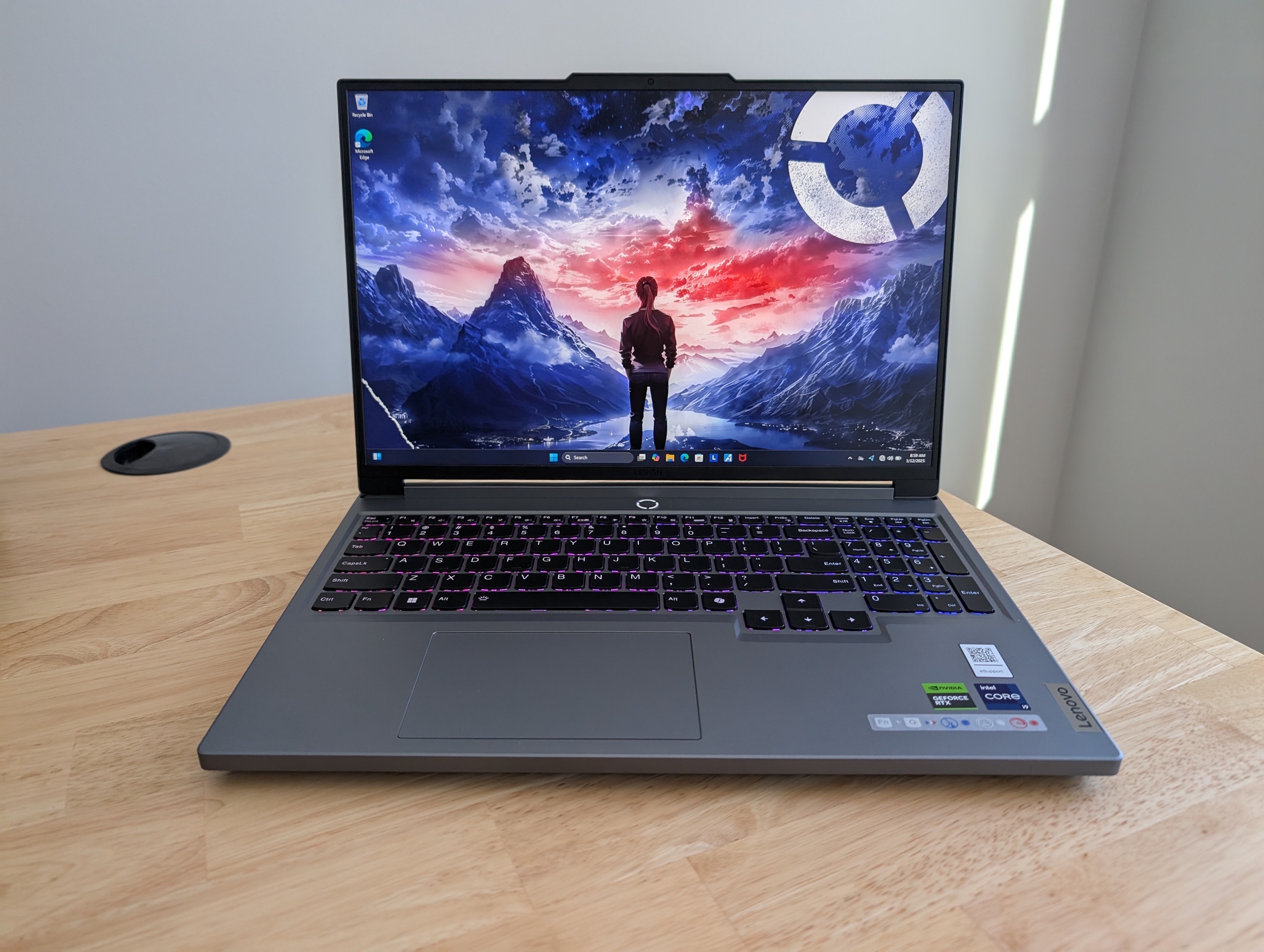
Looking for a gaming laptop? We’ve got your back.
It’s not just about chasing the flashiest specs — it’s about finding the right fit for how and what you play. Whether you’re after buttery-smooth 1080p gaming or maxed-out frame rates for competitive titles, there’s something here for you. Sure, a good GPU is key (obviously), but don’t sleep on display quality — a high refresh-rate can seriously level up your experience.
Every laptop on this last has been hands-on tested by our expert team, from graphics and screen quality to keyboard feel and ports. Let’s find your match.
Lenovo Legion 5i – Best overall gaming laptop

Pros
- Great GeForce RTX 4060 performance
- High-end CPU
- Solid build quality
- Nice cooling and vent positioning
Cons
- An RTX 4060 isn’t the fastest GPU
- Display is a little dim
- No fingerprint scanner or facial recognition hardware
- Battery life is on the low side
Price When Reviewed:
$1,399
Best Prices Today:
Who should buy the Lenovo Legion 5i?
If you’re after a gaming laptop that really delivers without wrecking your budget, this is the one. The Lenovo Legion 5i is fast, cool (literally!), and built to handle whatever you throw at it–whether that’s AAA titles, competitive shooters, or a little bit of everything. This is the laptop we’d recommend to most people because it gets all the important stuff right.
The Intel Core i9-14900HX gives you serious horsepower, and what’s really impressive is how quiet and cool the system runs even under heavy load. The RTX 4060 GPU pulls its weighs too, offering smooth gameplay on high settings, and it really shines with DLSS-enabled titles.
The 16-inch 165Hz screen is a real treat. It’s sharp, responsive, and roomy enough for both gaming and everyday multitasking. You’re also getting a spacious full-sized keyboard (with number pad!), customizable RGB lighting, and a 1080p webcam with a physical shutter switch. As a whole, this laptop really is the most well-rounded package.
Lenovo Legion 5i: Further considerations
The Legion 5i doesn’t try to be the flashiest or lightest laptop on the block and that’s okay. It focuses on what really matters–power, cooling, and value–and absolutely nails it.
You could spend more for an RTX 4070 setup, but unless you’re pushing the most demanding titles at ultra settings, the RTX 4060 inside this machine will keep you more than happy. The battery life is pretty average, as expected from a gaming laptop, but most of us game plugged in anyway.
Read our full
Lenovo Legion 5i Gen 9 review
Lenovo Legion Pro 7i 16 Gen 10 – Best high-end gaming laptop
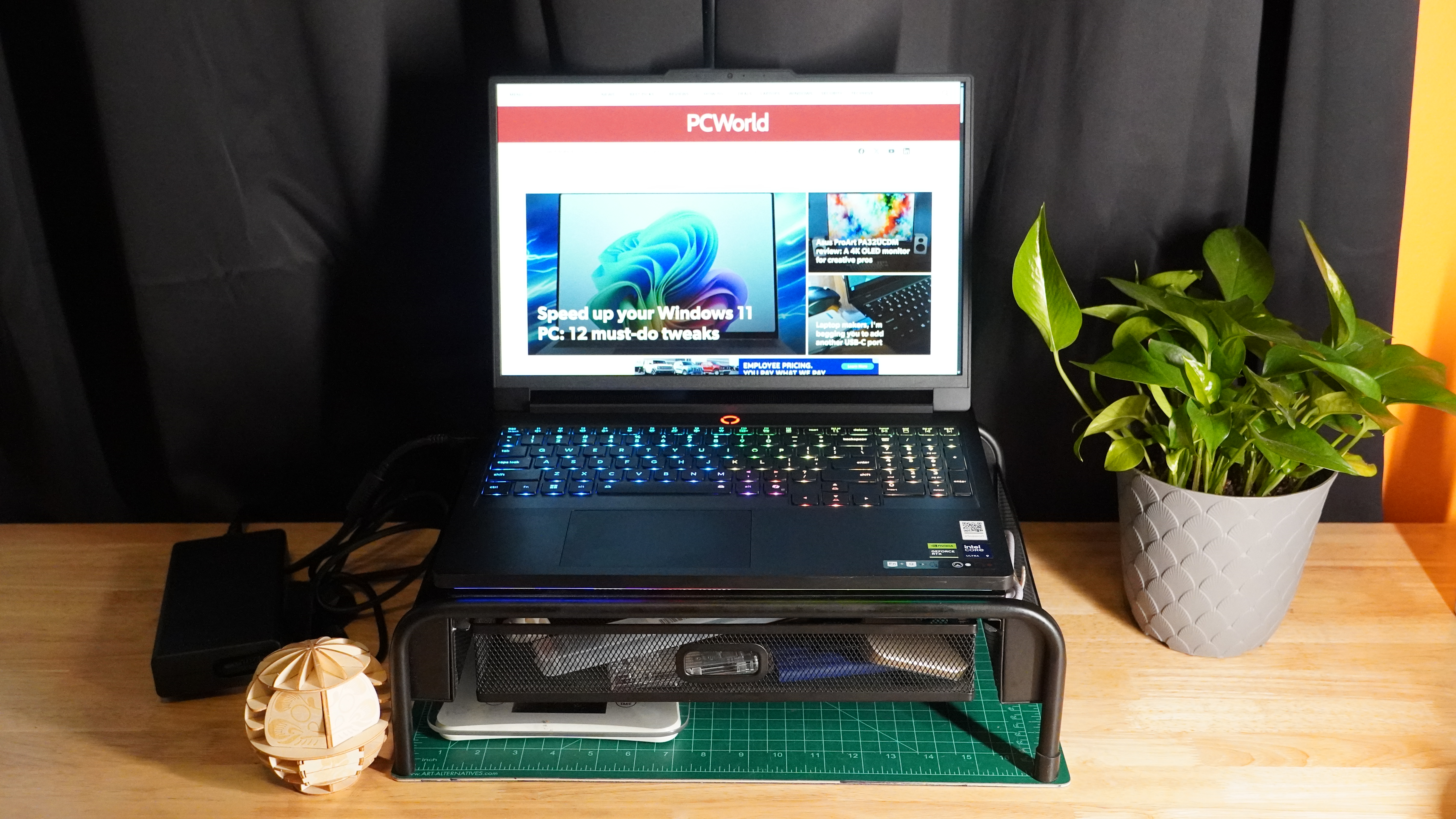
Pros
- Top-notch performance
- Excellent display
- Fast wired and wireless connectivity
- Supports USB-C charging
Cons
- Premium pricing
- Has the short battery life of a gaming laptops
- Trackpad could be bigger
Price When Reviewed:
$3,599
Best Prices Today:
Who should buy the Lenovo Legion Pro 7i 16 Gen 10?
If you want a no-compromises gaming machine, the Lenovo Legion Pro 7i Gen 10 is where it’s at. It has an Intel Core Ultra 9 275HX chip and RTX 5080 graphics, which is more than enough for buttery-smooth AAA gaming. The 16-inch 2560×1600 OLED display is also lovely! The wickedly fast 240Hz refresh rate makes games look insanely smooth.
Lenovo Legion Pro 7i 16 Gen 10: Further considerations
The Legion Pro 7i is pricey and not exactly backpack-friendly at more than 5 pounds, but if you’re chasing high frame rates and gorgeous visuals, this laptop delivers. Battery life isn’t its strong suit, so plan to stay plugged in for long sessions. But when it comes to raw gaming power, this one’s a beast.
Read our full
Lenovo Legion Pro 7i 16 Gen 10 review
Acer Nitro V 16 – Best gaming laptop under $1,000
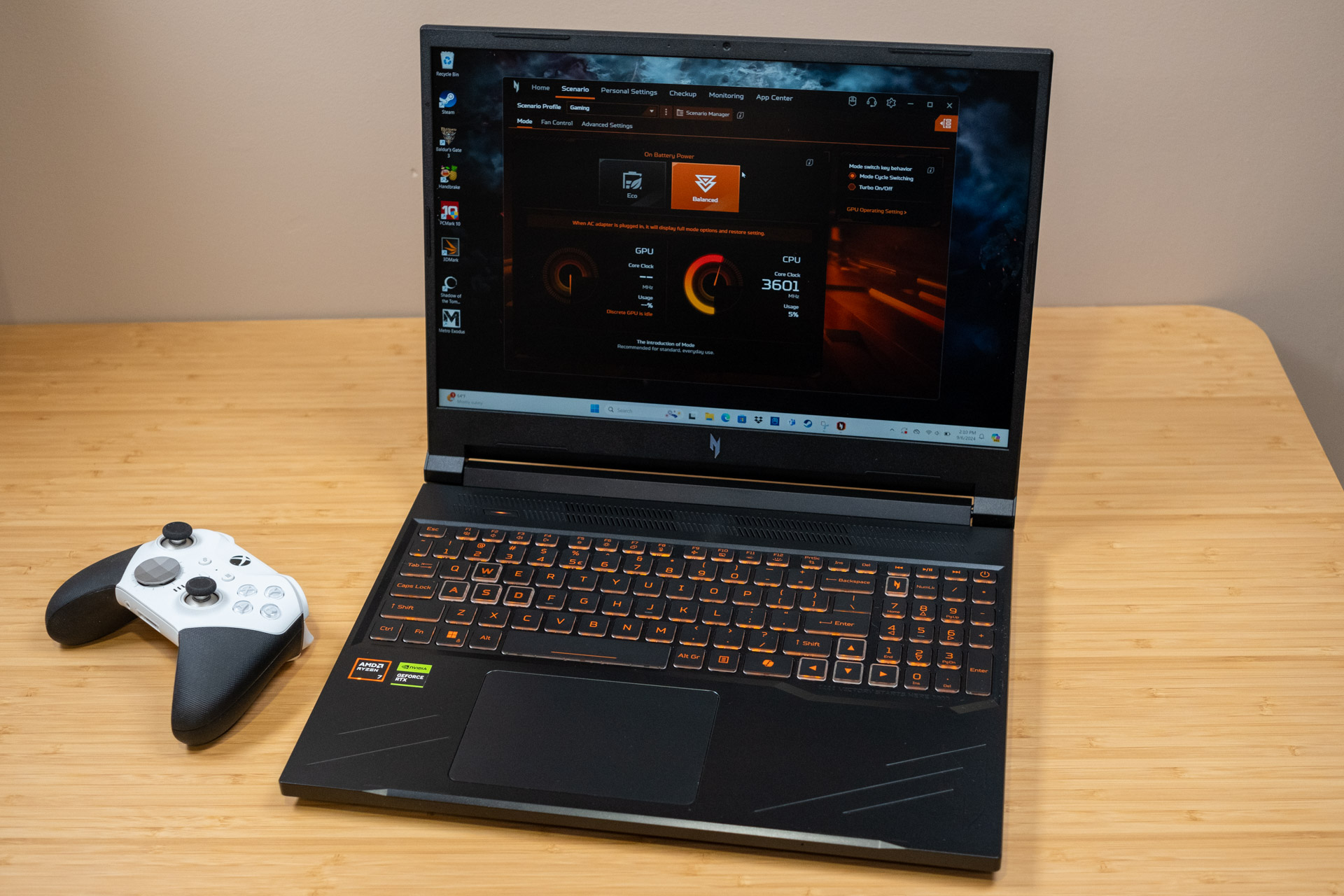
Pros
- Solid performance
- Competitive price
- Dedicated button for quick performance-mode switching
- Fast 165Hz display with good colors
Cons
- Fully plastic build
- Mushy keyboard
- Weak battery life
Price When Reviewed:
$1,099.99
Best Prices Today:
Who should buy the Acer Nitro V 16?
The Acer Nitro V 16 is a great budget pick for gamers. It actually packs a pretty good punch in the performance department, which is surprising given the low price. The AMD Ryzen 7 8845HS CPU and Nvidia GeForce RTX 4060 GPU will give you plenty of power for smooth 1080p gaming. The 16-inch 1920×1080 display is also big and fast. The 165Hz refresh rate makes everything from twitchy shooters to racing games feels smooth.
Battery life isn’t great, though. It clocked just around 4 hours in our tests, but that’s to be expected–it is a gaming laptop, after all. If you mostly game at your desk, then it’s not a deal breaker.
Acer Nitro V 16: Further considerations
This is a great pick for budget-conscious gamers who still want solid frame rates. You’re getting a lot of power for the money.
The plastic build is one area where costs are trimmed. It doesn’t feel cheap, but you’ll definitely notice it around the touchpad and vents, as it lacks that premium feel of metal. It’s still sturdy enough for daily use and the performance makes up for the plastic exterior.
Bottom line is, if you’re okay skipping the fancy materials, the Nitro V 16 delivers where it counts–gameplay.
Read our full
Acer Nitro V 16 review
HP Omen Transcend 14 – Most portable gaming laptop
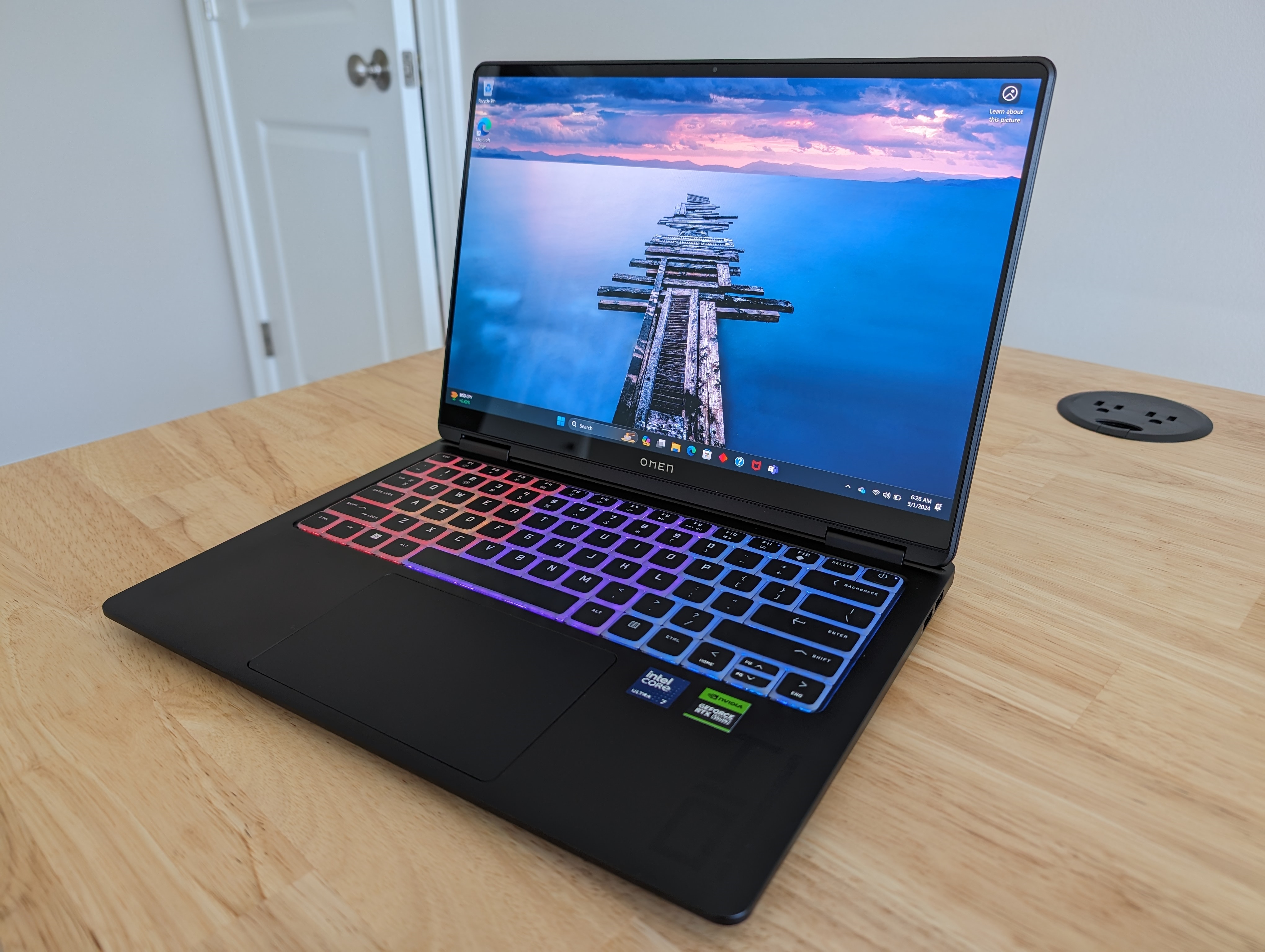
Pros
- Compact and lightweight
- Gorgeous OLED screen
- Good performance for the price
Cons
- Keyboard is a bit mushy
- Annoying bloatware
Price When Reviewed:
$1,699
Best Prices Today:
Who should buy the HP Omen Transcend 14?
If you want a gaming laptop that won’t break your back (or bag!), the HP Omen Transcend 14 is the one to watch. It weighs just a little over 3 pounds, which is wild for a laptop with this much power.
It runs on an Intel Core Ultra 7 155H CPU and an Nvidia GeForce RTX 4060 GPU, which means it can comfortably handle modern titles at 1080p. It’s also wrapped in a tough, all-metal chassis that feels premium and durable, not something you always get with portable gaming rigs.
HP Omen Transcend 14: Further considerations
This laptop is made for gamers who are always on the go. It’s slim, powerful, and has a battery that actually lasts. In our testing, it ran for 8.5 hours on a single charge. The 14-inch 1800p OLED panel is also a true beauty. It has rich colors, 500 nits of brightness, and a 120Hz refresh rate. Our reviewer, who’s used to IPS screens, was blown away by how vibrant and sharp this OLED panel looked in use. If you care about visuals and portability, this machine brings both to the table.
Read our full
HP Omen Transcend 14 review
Acer Chromebook 516 GE – Best gaming Chromebook
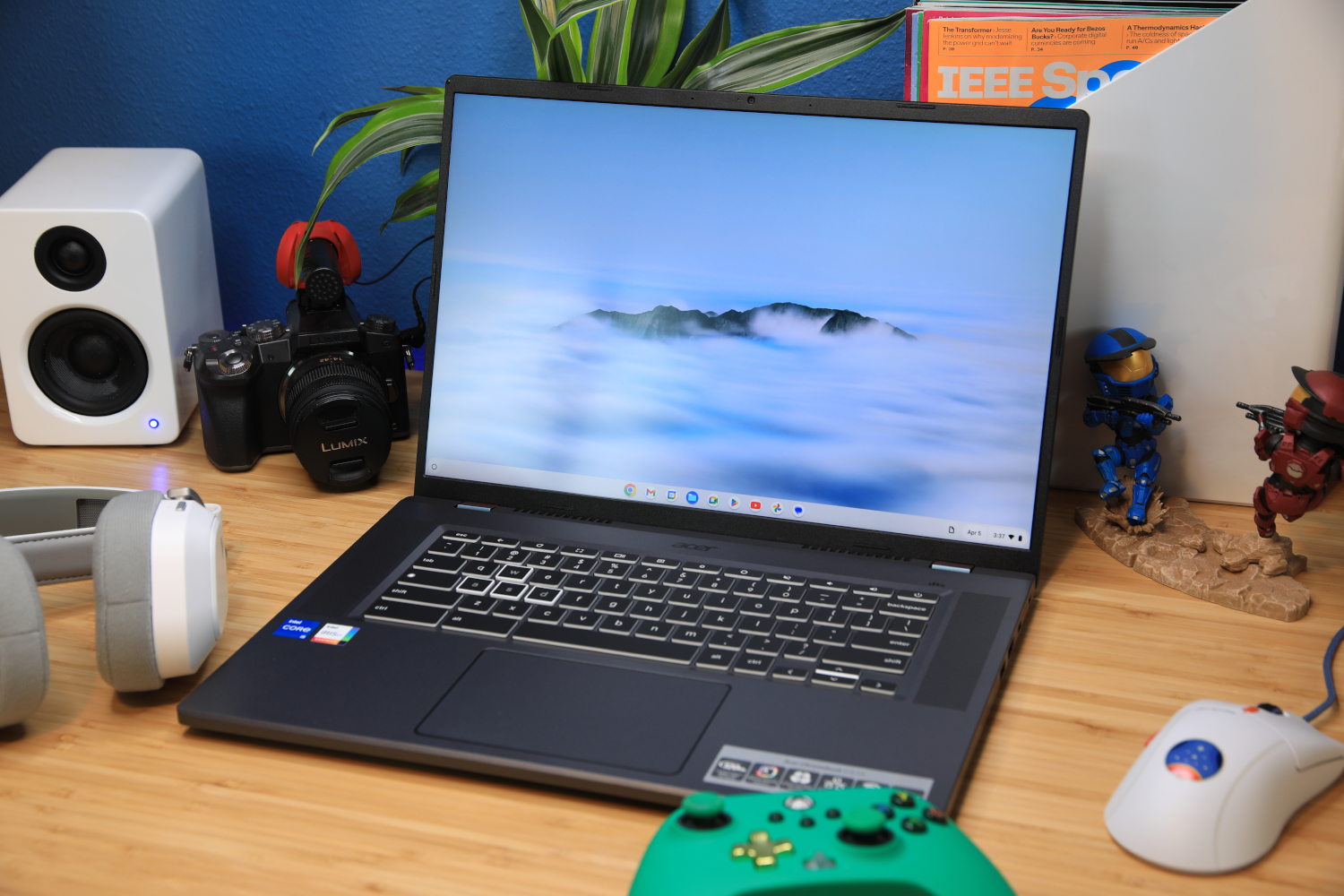
Pros
- Attractive design
- Excellent CPU performance
- Plenty of wired and wireless connectivity
- High-resolution 1600p display
Cons
- Mediocre keyboard and touchpad
- Disappointing speakers and microphone
- Display falls behind in contrast and color vibrancy
Price When Reviewed:
$649.99
Best Prices Today:
Who should buy the Acer Chromebook 516 GE?
If you’d like to give cloud gaming a try and also want something both lightweight and reliable, the Acer Chromebook 516 GE is a great pick. It doesn’t run games locally, but pair it with a GeForce Now or Amazon Luna subscription and you’re in for a surprisingly smooth ride.
The 16-inch 2560×1600 display is sharp and fast at 120Hz, and the Ethernet port is a must-have for a stable internet connection. It’s also just a solid everyday Chromebook for work or school.
Acer Chromebook 516 GE: Further considerations
This Chromebook was made for cloud gaming on the go. It’s got enough power for daily tasks and the gameplay feel great (as long as your internet’s up to the task). If you need offline play, you’ll want a Windows laptop instead.
Read our full
Acer Chromebook 516 GE review
Other gaming laptops we’ve tested
We’ve also tested a few other gaming laptops that impressed us, even if they didn’t make the top cut. The Alienware m18 is a monster with its massive 18-inch 2560×1600 LCD display and high-end specs–great for immersion, not so great for your backpack or budget. Same goes for the MSI Raider 18 HX AI: powerful, but pricey. On the flip side, the Lenovo LOQ 15 is a solid budget pick. For around $799, you get reliable 1080p gaming thanks to the RTX 3050 graphics card. It’s great for newcomers or anyone trying to save some cash.
How we test gaming laptops
The PCWorld team puts each and every Windows laptop through a series of benchmarks that test GPU and CPU performance, battery life, and so on. The idea is to push the laptop to its limits and then compare it against others we’ve tested. Chromebooks, on the other hand, go through a series of web-based tests.
For a much deeper look at our review methodology, check out how PCWorld tests laptops.
Why you should trust PCWorld for laptop reviews and buying advice
It’s in our name! PCWorld prides itself on laptop experience and expertise. We’ve been covering PCs since 1983, and we now review more than 70 laptops every year. All of the picks below have been personally tested and vetted by our experts, who’ve applied not only performance benchmarks but rigorous usability standards. We’re also committed to reviewing PC laptops at every price point to help you find a machine that matches your budget.
Who curated this article?
This article was curated by Ashley Biancuzzo, who oversees all of PCWorld’s laptop and Chromebook review coverage. Ashley has been deeply involved in the fast-paced world of consumer tech for years. She brings a sharp editorial eye to every review she edits or writes, evaluating every laptop across the spectrum, from budget-friendly options to high-end powerhouses.
How to choose the best gaming laptop
To find the best gaming laptop for your needs, pay close attention to the following features.
What’s the best screen for a gaming laptop?
When you buy a gaming laptop, one of the most important decisions you’ll need to make regards the screen. After all, what you get on day one is what you’re stuck with until you junk the device. You could run an external monitor, but then, what’s the point of a laptop? Look for an IPS or OLED display, though gaming laptops under $1,000 sometimes feature a TN panel. You can get buy with a 60Hz display if you mostly play single-player games, but thankfully, most gaming laptops these days opt for faster 120Hz+ panels instead.
What’s the best screen size for a gaming laptop?
The size of the screen dictates the size of the laptop itself, and thus weight. Think long and hard about whether you’re willing to take the weight penalty in exchange for the screen real estate.
What’s the best screen resolution for a gaming laptop?
The buzzword today is “4K.” That high resolution delivers sharper photo viewing and more space for video editing, but that doesn’t mean it’s for everyone. Anything not using the panel’s native resolution of 3840×2180, such as games running at lower-than-4K resolution, won’t look quite as sharp unless you exponentially increase the graphics power of the laptop.
If you’re running at 1920×1080 resolution because your GPU can’t hit 60fps at 4K, that feature is moot. For many gamers, 1920×1080 (1080p) or 2560×1440 (1440p) is more optimal.
IPS vs. TN vs. OLED: What’s the difference?
The panel technology is a key feature. IPS (in-plane switching) generally produces much greater color accuracy and superior off-axis viewing, but tends to lag in response times, which can lead to blurring. TN (twisted nematic) panels can offer far higher refresh rates and usually better response times than IPS, but can look washed out or just blah.
A middle-ground technology that’s appearing more often is VA (vertical alignment). VA is sometimes alternately referred to as “wide viewing angle” technology. (Many assume this spec to be IPS, but it’s not). In our experience, we’ve found VA panels to run the gamut from being worthy competitors to IPS to being worse than the better TN panels.
The wildcard in all this is OLED. Unlike IPS, TN, and VA, OLED panels don’t rely on edge- or backlighting where “black” is produced by a shutter-like mechanism that blocks light from coming through. Instead, each pixel generates its own light. To produce black, it just switches off the light. This amounts to truly stunning contrast ratios and vibrant colors. OLEDs also boast fantastic response times.
The negatives include smaller screen sizes (we haven’t seen anything larger than 15.6 inches yet), higher cost, and lack of support for variable refresh rate. OLED panels can also use more power than conventional methods if the image is on a white background.
Should a gaming laptop have G-Sync or FreeSync support?
Okay, we called this section G-Sync and FreeSync, but the reality is, when it comes to beefy gaming laptops, it’s a GeForce GPU world. And that means it’s a G-Sync world. In a nutshell, Nvidia and AMD’s respective variable-refresh-rate technologies help synchronize the monitor and the GPU to greatly reduce screen tearing. Variable refresh rates can make gaming at 40fps far smoother to your eyes than a screen without it.
The first variable-refresh-rate panels for laptops maxed out at 75Hz, only marginally better than the standard 60Hz. More recently, we’ve begun to see laptop panels that can push 120Hz, 144Hz, and even 240Hz. This generally means smoother and sharper gaming to your eyes. It even helps smooth out everyday tasks such as scrolling a browser page or Word document.
One last very important note: G-Sync screens have to be connected directly to the laptop’s discrete GPU, which means a large hit on battery life. In most laptops without G-Sync, the Intel integrated graphics is connected directly to the screen, so the GPU can be turned off when not being used. So while G-Sync is beautiful to behold, the cost in battery life is huge.
What should you look for in a gaming laptop keyboard and trackpad?
A new trend in gaming laptops is the offset trackpad, which is more conducive to gaming than a dead-center trackpad. The concept is sound, but anyone who actually cares about PC gaming will just plug in a mouse. The worst thing about that offset trackpad is when you try to use it for non-gaming purposes.
As far as keyboards go, the most important gaming feature is n-key rollover. This means the keyboard physically scans each key separately. If you wanted to, you could press 20 keys simultaneously and they’d all register, as each is independently wired. That probably sounds excessive, but keyboards that lack this feature can suffer missed keystrokes, which both ruins gameplay and hurts in everyday tasks.
Other keyboard considerations include LED backlighting (which adds ambiance but does nothing for gameplay) and mechanical keys vs. membrane. Mechanical keys are excellent—but are available on only a handful of laptops that usually weigh a ton. We have seen a few designs with low-profile mechanical keyboards, but even we admit they can be an acquired taste.
What kind of storage is best for a gaming laptop?
Having your games load from an SSD instead of a hard drive significantly cuts down on load times. But beyond that, we haven’t found it to matter that much whether it’s a super-fast NVMe PCIe drive or a slower SATA SSD.
What does matter more today is the size of the SSD rather than the interface it uses. With games now topping 50GB and some touching 100GBs, a once-spacious 256GB SSD will feel too small with just four games installed.
So when spec’ing out that gaming laptop, be mindful of just how much total storage you have. If you go for laptop with a small SSD and large hard drive combo, expect to install your games to the hard drive. If the laptop will have an SSD only, choose an absolute minimum of 512GB, with 1TB preferred.
How much RAM do you need in a gaming laptop?
When laptop makers spec out gaming laptops, one of the levers they use to try to convince you to buy their product is upping the amount of RAM. It’s not hard to find gaming laptops with “upgraded” configurations that go from 16GB of RAM to 32GB.
While having an adequate amount of RAM is important for gaming, today’s games typically top out at 16GB of RAM, and sometimes can run fine with just 8GB of RAM. Most people should invest in a gaming laptop with 16GB of memory if possible, and it makes sense to opt for 32GB if you plan on holding onto your gaming laptop for a long time. Modern games are only getting more memory-hungry.
Should a gaming laptop have dual-channel or single-channel RAM?
Besides the amount of memory, a couple of other important, but not critical, questions to ask is what clock speed and what mode. Modern CPUs let you run RAM in sets to increase the memory bandwidth.
More memory bandwidth immediately helps laptops that are running integrated graphics, but the conventional wisdom has long been that discrete GPUs in laptops don’t benefit as much because they have their own dedicated, much faster GDDR5 RAM to use. That’s typically the case, but the performance of today’s GPUs and CPUs can make this conventional wisdom wrong.
Gaming performance is often about a balance between the CPU and the GPU, and how graphically intensive a game is. With games that are graphically intensive, the GPU is the primary bottleneck on performance. Play a game that isn’t graphically intense, though, and the CPU can rapidly become the bottleneck on performance.
With the power of today’s GPUs, a lot of games, especially at a sedate resolution of 1920×1080, have shifted more performance to the CPU. The reason we’re talking about this now is if you rob the CPU of memory bandwidth, even a decently fast one, you can take a sizable hit in gaming performance.
The basic lesson is you should opt for dual-channel memory bandwidth configurations when possible. On a laptop spec sheet, you typically would see this expressed as “dual-channel” or “2 x 8” to indicate that two 8GB memory modules were used in a laptop.
Some laptop makers will express memory in clock speed, so you’ll see “DDR4/2,133 or DDR4/2,400.” While a higher memory clock does increase memory bandwidth, the impact isn’t quite as great as going from dual-channel to single-channel mode.
How many CPU cores do you really need in a gaming laptop?
For most people on a budget, a 4-core CPU with Hyper-Threading will function just fine in most games, especially when combined with a lower-cost and lower performance GPU.
Still, if you have the extra cash, a 6-core CPU with Hyper-Threading is likely the sweet spot for today and tomorrow. If you plan to stream your gaming live or edit it, investing in a 6-core is recommended.
Intel and AMD’s top-end 8-plus-core CPUs will deliver the greatest benefit to those who might do other graphics-intensive tasks, such as 3D animation or video editing. If you also plan to record and stream video, the 8-core will offer a performance benefit there, too.
If you’re thinking, great, let me buy a 4-core Core i5 or Ryzen 5 CPU with a luxury laptop to save money, you usually can’t, because PC makers typically only offer budget CPUs with other budget parts. Why? Well, most budget shoppers can’t afford any luxury items, and most PC makers like to add in the extras to increase the profit.
What GPU is best for a gaming laptop?
The single most important piece of hardware in a gaming laptop is undoubtedly the GPU. For AMD fans, the situation is as sad as it is in CPUs: It’s an Nvidia GeForce world. As with CPUs though, the good news is that the dominating products are top-notch.
The hardest part will be deciding just how much GPU you need. Our general guidance is to buy as fast a GPU as you can afford and are willing to heft. Generally, the faster the GPU (or GPUs), the larger and heavier the laptop. If you’re talking about playing on a higher-resolution panel of 2560×1440 at high-refresh rates, then keep increasing the amount of money spent on the GPU.
What kind of battery life should a gaming laptop have?
The last topic we’ll cover is battery life. The best way to understand battery life on a gaming laptop is to accept that it’ll be horrible for all things gaming.
The minute you crank up a GPU on a gaming laptop to play a game, you’re basically limiting yourself to an hour or an hour and a half of battery runtime. Period. And in some cases, far less than that.
The only reason to consider battery life on a gaming laptop is if you want to use your laptop unplugged for non-gaming purposes. In that respect, you’ll find a lot of variance, with some offering decent battery life, albeit with a trade-off in gaming performance.
FAQ
What is the best gaming laptop?
The Lenovo Legion 5i is PCWorld’s top gaming laptop. It delivers great performance and it stays relatively cool under load. It won’t burn a hole in your wallet, either!
What is the best cheap gaming laptop?
The Acer Nitro V 16 is PCWorld’s best cheap gaming laptop. You get solid 1080p performance thanks to the RTX 4060 graphics, and the 165Hz display ensures smooth gameplay.
When is the best time to buy a gaming laptop?
The best time to pick up a gaming laptop is during Black Friday, Cyber Monday, or back-to-school season. Those deals will save you a lot of cash.
Should you get a gaming laptop or a PC?
It really depends on your lifestyle. If you’re someone that’s always on-the-go, a gaming laptop is a good fit. But if you’re okay with staying in one spot and want more power or upgrade options, a PC is a better choice.
What’s the difference between a gaming laptop and a regular laptop?
A gaming laptop is made for handling games, so it has beefed-up graphics and better cooling. A regular laptop, on the other hand, is designed for everyday stuff like browsing or working on documents and operating unplugged for extended periods of time.




:max_bytes(150000):strip_icc():format(jpeg)/Angelina-Jolie-Chopard-dinner-051625-1-3e3c829e804a4036a3590c4919cdcf2c.jpg)




